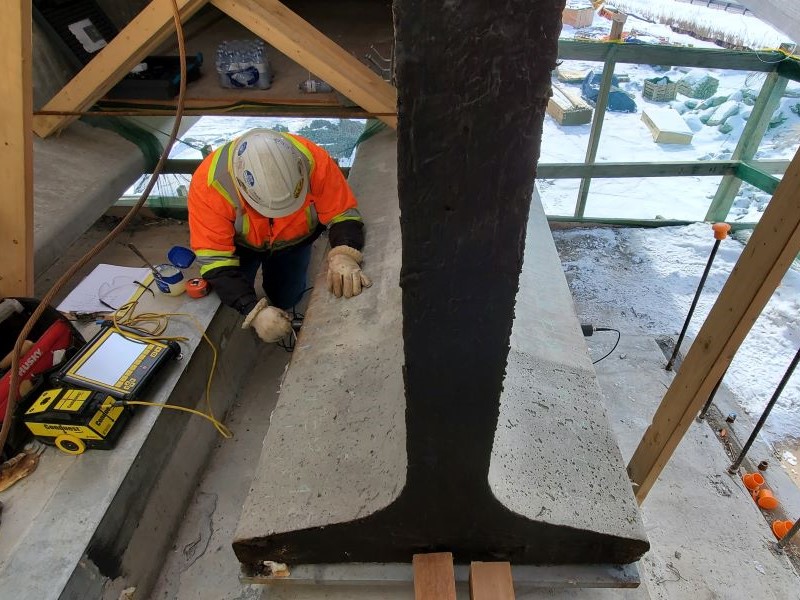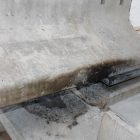Precast concrete elements are usually manufactured and cured in a controlled environment. This controlled process results in high quality and consistency of the end products. However, construction errors, formwork issues, and damages during transportation and installation can impact the quality, and integrity of these precast elements. Non-destructive testing methods can help evaluate the extent and severity of damages, and help precast manufacturers and contractors with better tools in assessing the problems and reducing the interruption in construction schedule.

What Impacts the Quality of Precast Concrete?
The quality of precast concrete can be affected by several factors, including the following:
- Concrete mix design: The quality of the concrete mix is an important factor in the overall quality of precast concrete. A well-designed mix will have the right balance of ingredients, including water, cement, aggregate, and other additives, to ensure that the concrete will have the desired strength, workability, and durability.
- Formwork: The quality of the mold or formwork used to produce the precast concrete element is also important. The mold or formwork should be of sufficient strength to withstand the weight of the concrete and should be accurately dimensioned to produce elements with the desired shape and size.
- Casting and curing: The casting and curing of the precast concrete elements is critical to their quality. The concrete must be properly mixed and placed into the mold or formwork, and then cured under controlled conditions to ensure that it reaches its desired strength and durability.
- Transportation and handling: The transportation and handling of precast concrete elements is also critical to their quality. The elements must be protected from damage during transportation, and they must be properly handled and placed into position at the construction site to minimize the risk of damage or failure.
- Accidents/Incidents: Construction site accidents may negatively impact the integrity of precast elements. Fire, impact loads, and excessive backfilling pressure can negatively impact the precast elements.
Non-Destructive Evaluation for Precast Concrete
Various Non-Destructive Testing and Evaluation Methods exist for assessing the quality and integrity of precast concrete components. Depending on the nature of the problem, the right set of tools can be deployed to assess the location, extent, and severity of defects.
1. Assess the Quality and Integrity of Precast Concrete
Errors in the concrete mix, placement, formwork, and transportation can impact the uniformity and structural integrity of precast concrete elements. Some examples are:
- Poorly consolidated concrete or honeycombed concrete
- Damaged Concrete Girders (during transportation or installation)
- Integrity of precast beams, walls, and slabs (Double T beams)
- Integrity of utility valves, watermain chambers, etc.
Rebound Hammer – The test provides a cost-effective and rapid means of assessing the overall uniformity across large areas. The test can be used to identify the location of poor-quality concrete.
Ultrasonic Pulse Velocity – The test provides more precise information about the quality and integrity of the concrete.
Ultrasonic Pulse Echo tomography and Impact-Echo provide valuable information about the overall quality and integrity of the component.

2. Evaluate Cracks in Precast Concrete Elements
Cracks can happen during construction, curing, transportation and handling, and during the installation in construction projects. While most of these cracks do not have a significant impact on the integrity or durability of concrete elements, major cracks can be a source of concern.
Non-destructive Testing and Evaluation can be used to assess the integrity of precast elements on or around the cracks.
Rebound Hammer – The test provides a cost-effective and rapid means of assessing the overall uniformity adjacent to cracks.
Ultrasonic Pulse Velocity – Ultrasonic Pulse Velocity can be used to estimate the depth of cracks. Crack severity can be assessed using a crack width ruler.

3. Verify the Thickness of Precast Components
For existing precast components with no proper documentation, assessing the thickness of the element is an important step toward evaluating its adequacy for the new loads.
Ultrasonic Pulse Echo is widely used by engineers to assess the thickness of concrete elements. This is especially important in concrete elements with one-side access (Single Side Access), such as:
- Tunnel linings: Thickness measurement is critical in the QC process for tunnel linings. It is also an important parameter for structural evaluation purposes.
- Trunk Sewers: In trunk sewers, UPE can help engineers estimate the thickness of existing lining. This becomes extremely challenging because intrusive methods involving hot work with core drilling is not a safe nor cost-effective solution. Moreover, there is always the risk of coring in shallow sections with high hydrostatic pressure.
- Concrete Tanks: Testing concrete tanks that are used in industrial chemical processes is often challenging. Maintenance managers of such facilities often have very short downtime windows, and permission to get inside the tank is not always practical (unless during essential maintenance cycles). UPE enables thickness measurement and quality assessment from the exterior face.
4. Grouting Defects in Post-Tensioning Ducts
Voids and other anomalies are common problems in the grouting of post-tensioning ducts. Non-destructive testing methods can help identify the location and extent of these anomalies.
- Ground Penetrating Radar (GPR) can be used to assess the location of post-tensioning ducts from the surface of precast concrete elements.
- Ultrasonic Pulse Echo Tomography scanning can provide critical information about voids and defects that might have happened during the grouting process of tendon ducts in post-tensioned concrete elements.






